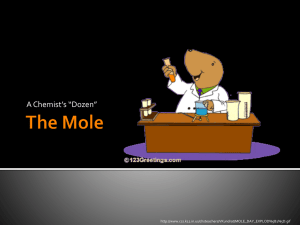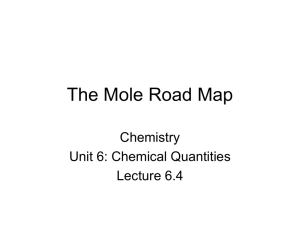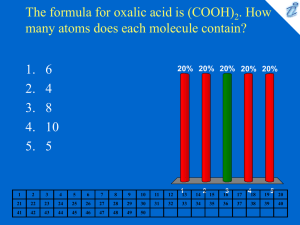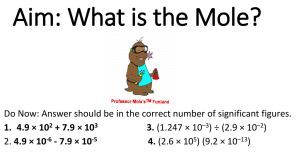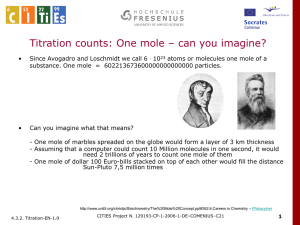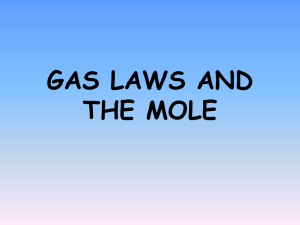PPT
advertisement
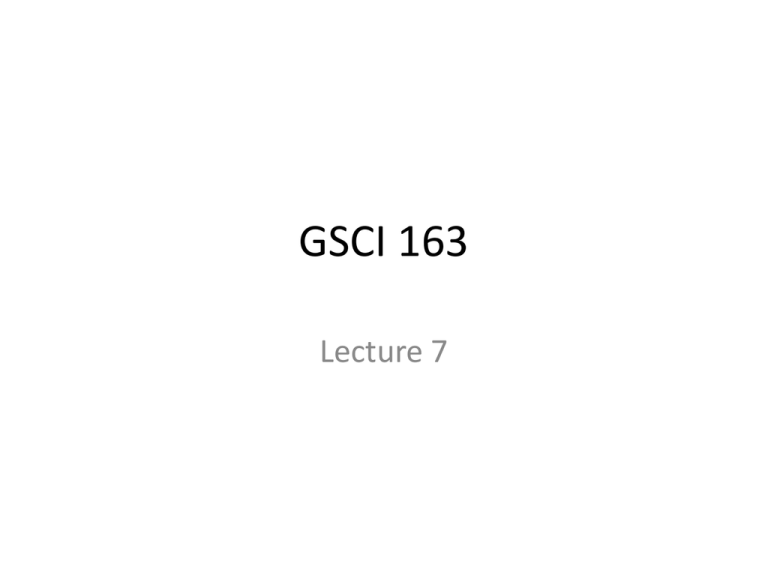
GSCI 163 Lecture 7 Review • Elements combine in chemical reactions to produce new substances with different chemical properties. • Balancing chemical equations require: – Keeping the same number of elements on both sides of the chemical equation by adjusting coefficients (never subscripts of the chemical formula) Activity • Determine the chemical formula (yourself) of each substance in the following chart • Find the appropriate chemical equation (your partner in the reaction) • Balance the chemical equation for each reaction Find your partner and write the chemical reactions 1) Copper + sulfur Copper(II) sulfide 2) Calcium oxide + water Calcium hydroxide 3) Hydrogen + nitrogen 4) Chromium + oxygen 5) Aluminum + bromide 6) Sodium + iodine 7) Hydrogen + chlorine How much is produced? • In a chemical reaction, a certain mass of reagents combine to produce a certain mass of products. Consider the following reaction: 2Na + I2 2NaI Here two atoms of sodium react with one molecule of iodine to produce two molecules of sodium iodide. Problem How much sodium iodide is produced when 10 grams of sodium react with 20 gram of iodine? • Questions that need to be answered: – How many atoms are there in 10 grams of Na? – How many molecules are there in 20 g of I2? Start with atomic weight 2Na + I2 2NaI 1 u = weight of 1/12 of 12C • Atomic weight of Na = 23u, iodine = 127u. Formula weight is the sum of the weight of the elements of the compound Formula weight of iodine molecule = 254u Formula weight of sodium iodide = 150u 2 x 23 u + 254 u = 2 x 150u 300 u = 300 u Moles and Avogadro’s number 23 g of Na (atomic weight = 23u) correspond to 6.02 x 1023 atoms of Na and 1 mole of Na 254 g of I2 (formula weight = 254u) correspond to 6.02 x 1023 molecules of I2 and 1 mole of I2 150 g of NaI (formula weight = 150u) correspond to 6.02 x 1023 molecules of NaI and 1 mole of NaI Avogadro’s Number Number of atoms How many atoms are in 10 g of sodium? 10 g x 6.02 x 1023 atoms = 2.63 x 1023 atoms = 26.3 x 1022 atoms 23 g How many molecules in 20 g of iodine? 20 g x 6.02 x 1023 molecules 254 g = 4.74 x 1022 molecules Reaction 2Na + I2 2NaI Each molecule of iodine reacts with 2 atoms of sodium to produce 2 molecules of NaI Thus, 4.74 x 1022 molecules will react with 9.48 x 1022 atoms of sodium, producing 9.48 x 1022 molecules of NaI Final product • 16.8 x 1022 atoms of Na are left out. We say that one of the reagents (iodine) was used up. (This corresponds to 6.4 g of Na) To answer our initial question: • (9.48 x 1022) x 150 g / 6.02 x 1023 = 23.6 g of sodium iodide was produced Can we make this simpler? Use moles instead: 1 mole = 6.02 x 1023 atoms, molecules, etc Thus, • 23 g of Na is 1 mole 10 g of Na is 0.435 mole • 254 g of I2 is 1 mole 20 g of I2 is 0.079 mole Reaction 2Na + I2 2NaI Each molecule of iodine reacts with 2 atoms of sodium to produce 2 molecules of NaI Thus, 0.079 mole of iodine will react with 0.157 (2 x 0.079) mole of sodium, producing 0.157 mole of NaI Final product • 0.277 mole of Na are left out (0.435 - 0.157). We say that one of the reagents (iodine) was used up. (This corresponds to 6.4 g of Na) To answer our initial question: • 0.157 x 150 g = 23.6 g of sodium iodide was produced Recipe 1. Find the formula weights of the compounds involved in the reaction 2. Calculate the number of moles given by the actual mass of reagents 3. Calculate the number of moles of reagents used in the reaction 4. Calculate the number of moles of product produced 5. Convert the number of moles of the product to mass using the formula weight of the product Exercise: calculate the mass of water produced by the reaction of 10 g of hydrogen gas with 10 g of oxygen gas. How we classify reactions • Combination or synthesis X + Y XY • Decomposition reaction XY X + Y • Replacement reaction XY + Z XZ + Y • Ion exchange reaction 3Ca(OH)2 + Al2(SO4)3 3CaSO4 + 2Al(OH)3 • Redox reaction – Gain and losses of electrons Types of chemical reaction Next class • Solutions and numerical representation.
